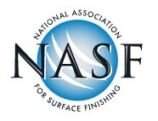Recommended Time & Experience: No experience or training the in the art and science of electroplating. For those a few years away from taking any chemistry courses, the online Chemistry Refresher course offered by NASF Foundation is highly recommended, but not required as a pre-requisite.
Description: This course presents a broad range of information related to preparing parts for precious metal plating as well as exploring Precious Metal (PM) plating processes. It also covers best practices for troubleshooting and problem solving this technique.
Core Elective: Master Surface Finishers (MSF) designation.
Designed For: But not limited to: Operators, Supervisors, and Sales personnel of facilities specializing in PM plating and those selling and supporting the PM industry.
Course Content Level: Intermediate (200 Level)
Approx Hours to Complete: 10 Hours
Learning Objectives: Those completing this course and/or earning a certificate in Industrial & Precious Metal Plating are able to demonstrate:
- An understanding of the pre- and post-treatment and underlays required for successful PM plating.
- Aspects of reel-to-reel plating technologies used for PM plating.
- Distinguish the features of PM chemistries and operational conditions including gold, palladium, palladium-nickel, platinum, rhodium, silver, and tin.
- Articulate the alternatives to plating including High Velicity Oxygen Fuel (HVOF) and plasma spray.
Course Options
Web-Based
Dates: May: 7, 8, 14, 15, 21, 22, 28, 29
Registration Deadline: March 1, 2024
Member: $900 | Non-member: $1,300
Home-Study
Member: $900 | Non-member: $1,300
Optional Exam
Member: $200 | Non-Member: $300
Course Description
- 1. Preparing Metals for Plating, Part 1
- This lesson will provide guidance on cleaning, acid pickling and other methods of preparing substrates made of copper, zinc, “white metal” and aluminum alloys for precious metals plating.
- 2. Preparing Metals for Plating, Part 2
- This lesson will provide guidance on cleaning, acid pickling and other methods of preparing substrates made of ferrous, nickel, and other alloys for precious metals plating.
- 3. Reel-to-Reel Plating
- This lesson details the technologies used in continuous reel-to-reel plating systems. Included are discussions on equipment, high speed plating issues and how to calculate the maximum line speed when multiple layers of plating are specified. A special focus is given to techniques for selective plating.
- 4. Industrial Nickel Plating
- This lesson provides detailed guidance on the sulfamate nickel plating process, including chemical make-up, operational conditions, and control of impurities. There is special focus on the impact of impurities on internal stresses in the nickel deposit. Alloys of nickel such as tin-nickel, nickel-cobalt and nickel manganese are also covered, as are strike solution formulas and their use.
- 5. Gold Plating
- This lesson covers the major gold plating processes, including cyanide, acid, and neutral formulations. Chemical make-up, equipment, operational conditions and impurity control are major topics in this lesson. A special focus is given to minimizing porosity in gold deposits.
- 6. Decorative Gold Plating
- This lesson will provide detailed information on decorative gold plating, especially for jewelry applications. Significant time is devoted to the discussion of coloration in gold alloy plating. Another focus of this lesson is plating gold from the sulfite process.
- 7. Silver Plating
- This lesson provides detailed information on silver plating for jewelry and electronic applications. The lesson covers chemical make-up and operational conditions for both cyanide and non-cyanide-based silver plating solutions. Significant time is devoted to carbonate generation and treatment.
- 8. Palladium, Palladium-Nickel, Platinum and Rhodium Plating
- Each of the titled plating processes is covered, from chemical make-up to operational conditions. A special focus is a comparison of each process and deposit with the others.
- 9. Tin Plating
- This lesson covers tin plating from acidic and alkaline processes. Chemical make-up and operational conditions are the main focus of this lesson. A discussion of the causes and prevention of tin whiskers is provided, along with anode filming methods for the alkaline process. A focus of this lesson is solderability as it relates to tin and bright tin deposits.
- 10. Alternatives to Electroplating
- Alternatives such as physical vapor deposition, HVOF Spray, Plasma Spray and Sputter Ion Plating are covered in this lesson. For each technology, advantages and disadvantages are discussed.
